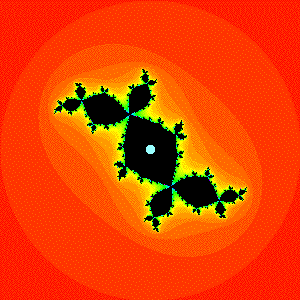Back
to Index
Next Section
5 How to Count
Now let's use the rotation numbers to investigate the arrangement of the
bulbs around the main cardioid. This is one of the main experiments performed
in the chaos club. The idea is to use the computer to determine experimentally
the location of the p/q bulbs for q between 2 and 7. A number
of these are sketched in Figure 7. Note that the bulbs are ordered exactly
as the rational numbers! The fact is that there is a unique p/q
bulb for each rational between 0 and 1 and these fractions are ordered
in the natural way around the cardioid (beginning at 0 at the cusp and
proceeding in a counterclockwise direction around the boundary ending at
1, again at the cusp). That is, the Mandelbrot set serves as a real number
line (or at least a rational number line). Moreover, unlike the real line,
each number on
M can be clearly identified by looking at the antennas
and counting the spokes.

Figure 7
The reason why this is true demands a bit of complex calculus. Recall
that the fixed points of Fc are given by the roots of
x2
+ c = x which are

We have

Along the boundary of the main cardioid, we saw earlier that

As  increases from 0 to 2 Pi, c travels once around the boundary of
the cardioid in the counterclockwise direction. It follows that the fixed
points are given by
increases from 0 to 2 Pi, c travels once around the boundary of
the cardioid in the counterclockwise direction. It follows that the fixed
points are given by

when c lies on the boundary. Note that

so that  is a neutral fixed point. If we were to compute the value of
is a neutral fixed point. If we were to compute the value of  at the point where the p/q bulb attaches to the main cardioid, then
it is a fact that
at the point where the p/q bulb attaches to the main cardioid, then
it is a fact that
theta = 2 * pi * p/q
What happens is a fixed point and a period q point coalesce into
a neutral fixed point whose derivative is
 .
For c inside the cardioid, the fixed point is attracting. For c
on the boundary, the fixed point ceases to be attracting; nearby orbits
tend to rotate p/q revolutions around
.
For c inside the cardioid, the fixed point is attracting. For c
on the boundary, the fixed point ceases to be attracting; nearby orbits
tend to rotate p/q revolutions around  (at least infinitesimally). When c is in the p/q bulb, this
fixed point is now repelling while the cycle becomes attracting and inherits
the rotation. A "movie'' of this is shown for the 1/3 bulb in Figure 8.
(at least infinitesimally). When c is in the p/q bulb, this
fixed point is now repelling while the cycle becomes attracting and inherits
the rotation. A "movie'' of this is shown for the 1/3 bulb in Figure 8.

Figure 8. A movie of the attracting cycle in the 1/3 bulb.
Back to Index
Next Section





 increases from 0 to 2 Pi, c travels once around the boundary of
the cardioid in the counterclockwise direction. It follows that the fixed
points are given by
increases from 0 to 2 Pi, c travels once around the boundary of
the cardioid in the counterclockwise direction. It follows that the fixed
points are given by


 is a neutral fixed point. If we were to compute the value of
is a neutral fixed point. If we were to compute the value of  at the point where the p/q bulb attaches to the main cardioid, then
it is a fact that
at the point where the p/q bulb attaches to the main cardioid, then
it is a fact that
 .
. (at least infinitesimally). When c is in the p/q bulb, this
fixed point is now repelling while the cycle becomes attracting and inherits
the rotation. A "movie'' of this is shown for the 1/3 bulb in Figure 8.
(at least infinitesimally). When c is in the p/q bulb, this
fixed point is now repelling while the cycle becomes attracting and inherits
the rotation. A "movie'' of this is shown for the 1/3 bulb in Figure 8.